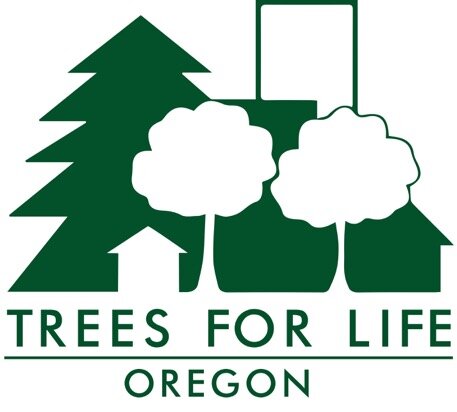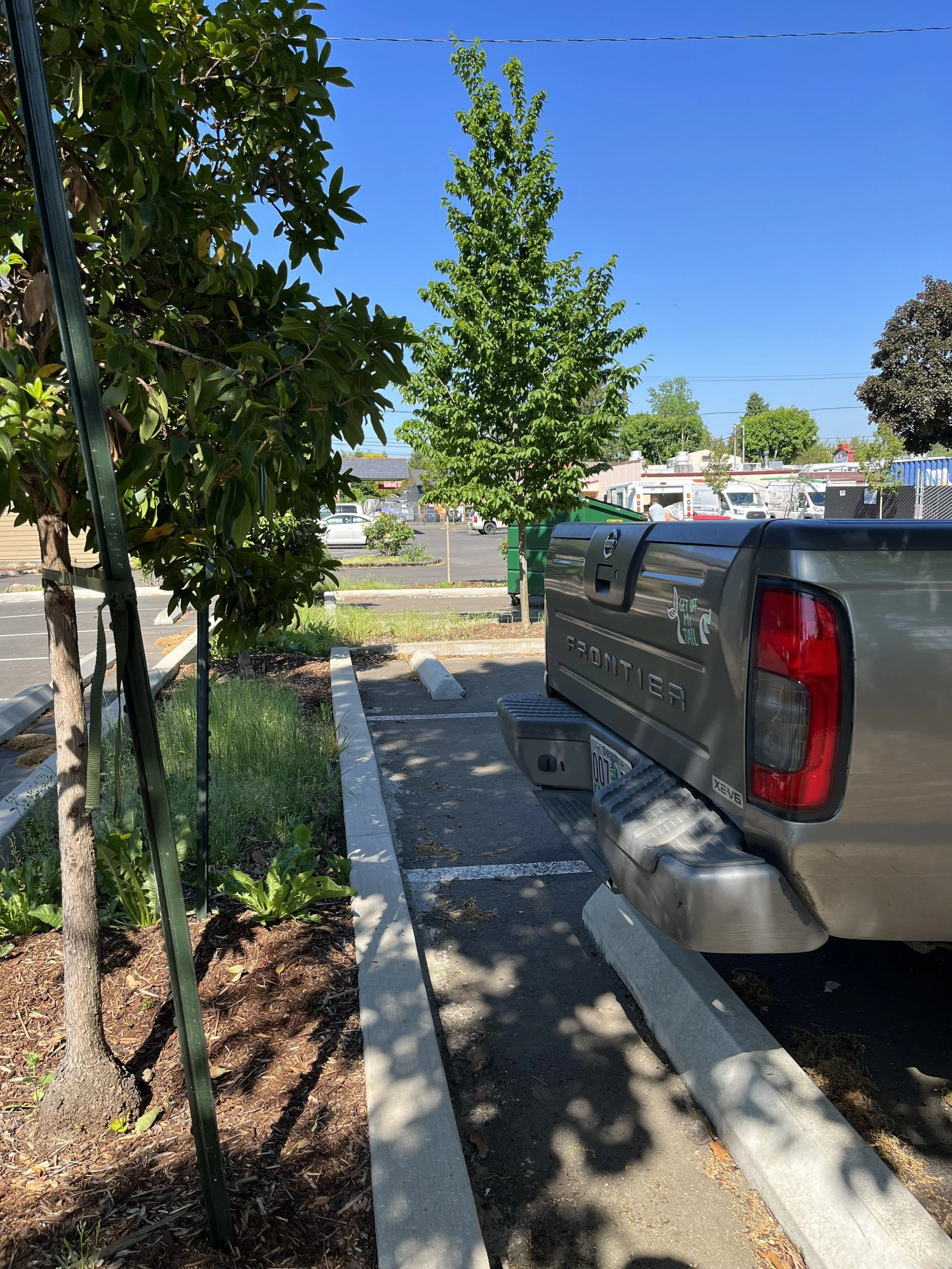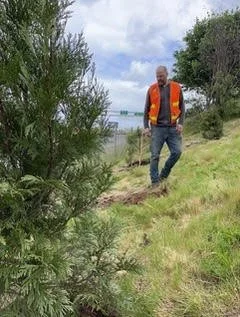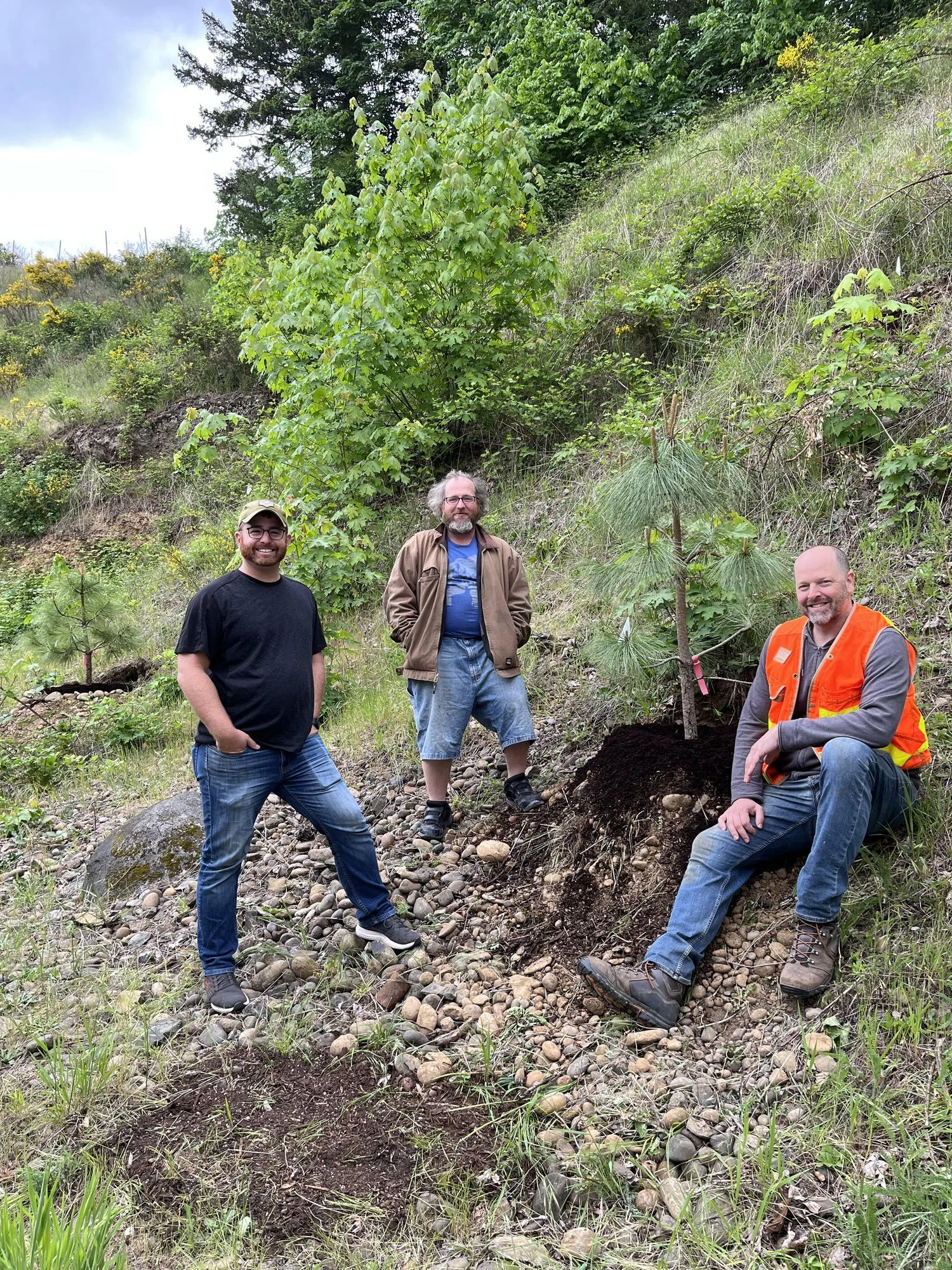Private Properties Hold the Most Space for New Canopy: How Might Portland Act on That?
City Council shies away from mandates on yard trees. But why not build on an existing, opt-in program that’s partnering with property owners to plant climate-forward trees on private land and securing owners’ buy-in to care for them?
By Kyna Rubin
The European hornbeam planted in an extension built into one of the hotel’s parking spaces. All photos by Catherine Mushel for Trees for Life Oregon.
Ken’s nearly one-acre property on SE 82nd Avenue, south of Brooklyn Street, holds a 60-unit hotel that covers a quarter of the site. The other three-quarters is a parking lot that bakes in summer. Until July 2020, the lot’s planting strips held poor soil and nothing but rocks. Today, these various-size strips house some 30 trees. The property owner also sacrificed two parking spaces that he says he didn’t need to add two long bump-out extensions for holding large-form trees.
The climate-resilient species planted here are already big enough to provide shade, says Ken, Unicorn Inn’s property owner, who prefers not to give his last name. “If I had done this myself it would have cost tens of thousands of dollars,” he says. It wouldn’t have happened.
What did happen is that in May 2020 Ken received a flyer from Portland’s Bureau of Environment Services (BES) tree program asking if he was interested in free trees, planting, watering for four summers, and pruning after five years. He hadn’t really thought about planting trees, but this offer “sounded too good to be true.” When BES confirmed the details over the phone, he said, “sign me up.”
“They delivered even more than they promised,” says Ken, who was told he was the first property owner to respond to BES’s expansion of its tree planting to commercial property owners. Lea Wilson, an arborist with the BES tree program, partnered with Ken on site. Together they selected and sited the trees, careful to provide extra protection from vehicles for trees in the new extensions.
BES even provided new, metal stakes for the young trees when nearby homeless people stole the original wooden stakes, presumably for firewood. BES’s four-summer watering is crucial, because Ken’s property has no irrigation system.
“Sixty-two percent of citywide potential to plant new canopy is on private land, mostly yards but also commercial and industrial sites.”
The strawberry, crape myrtles, incense cedar, and evergreen oaks Ken helped choose from BES’s suggested list have low water needs once established. After BES and its contractor Treecology leave the premises in a few years, the trees have a steward in Ken. If necessary, he says he will hand-water them or use waterbags during hot summer spells.
Private Lots in the Current Canopy Context
Securing commercial site owners’ cooperation like Ken’s to plant trees in large parking lots, and depaving in the process, will help the City combat heat islands in low-canopy parts of town.
BES aligned this strawberry tree with the parking space line to prevent damage from parked cars.
The nonprofit organization Depave is already doing some of this, but having the City engage in it multiplies the effect. These kinds of efforts are important because they get more shade onto highly paved private properties that would otherwise remain treeless. Further, planting on big private commercial and industrial sites in particular fosters large-scale planting and economies of scale. (Read farther below about a larger BES planting in and around the transitional tiny homes that make up Agape Village at highway 205 and SE Powell Boulevard.)
Expanding our canopy is not a luxury but an imperative for protecting Portlanders’ lives in a changing climate with already extreme heat waves. Fortunately, a lot of attention is being given to urban trees right now. Portland’s Urban Forest Plan is being updated after 20 years. On the heels of that process, the City will be revising its tree code.
And the Portland Clean Energy Fund (PCEF) is about to invest $40 million over five years to plant and maintain thousands of new street and yard trees in the most heat-vulnerable, low-canopy parts of town. With so much investment at stake, now is the time to be strategic about where the new trees will go. (Read here about what Portland is doing to source and plant climate-resilient tree species.)
Because the City owns and regulates trees in parks and the public right-of-way, most of its tree planting has been directed there. With some exceptions, City code steers clear of governing private-property trees in non-development situations. The reasons for this are likely legal and cultural—City government wants to avoid lawsuits over private property rights.
The wheel stops BES provided will protect newly planted trees from vehicle damage.
Yet 62 percent of citywide potential to plant new canopy is on private land, mostly yards but also commercial and industrial sites, according to a 2018 Urban Forestry report; only 16 percent of potential lies in the public rights-of-way (ROW). Space-wise, private properties offer much greater opportunity to hold the good-size, long-lived, climate-resilient trees we need to keep Portland livable. Our existing curb planting strips are simply insufficient in size and number to house all the new canopy required to keep us safe and healthy in a changing climate.
This is especially the case in Portland’s historically marginalized, low-canopy communities slated to benefit from PCEF’s new Equitable Tree Canopy Program. Unlike leafy, wealthier neighborhoods like Eastmoreland and much of Irvington, which decades ago were designed from the start with space to hold large, shade-giving street trees, low-income parts of the city were never fashioned to hold the big-canopy street trees residents need, now more than ever, for health and well-being.
Some Small Headway Occurring
Aware of the limited space to plant new, large, climate-smart street trees, and after pressure from advocacy groups, the Portland Bureau of Transportation recently updated its Pedestrian Design Guide to include some positive changes such as allowing developers to build curb bump-outs to hold trees along roads with tiny or no strips for street trees. That’s a constructive move, but unless such curb redesign is mandated it is unlikely to be widely adopted.
“We should be exploring multiple ways to put big trees into existing space that already can accommodate them. ”
Another sign that the City is listening is the new pilot project along SE Duke Street that PBOT and Urban Forestry are partnering on to gauge how curb bump-outs might work for new housing and improved road projects. PBOT says that if the project is a success, the idea is to expand the design more broadly across the city. PBOT staff say the bump-out standards being developed under the pilot project could potentially be used in already designated Neighborhood Greenways or as part of the sidewalks that PBOT requires developers to build to bring new street frontage up to code (TFLO is following this project and will report on it in the next several months.)
A climate-resilient crape myrtle planted in the Unicorn Inn parking lot. Crape myrtles are beautiful bloomers.
Clearing bureaucratic and financial hurdles to grow these bump-outs citywide will no doubt take political will, investment, and many years.
Meanwhile, we need now, not years from now, big-picture, creative thinking to reconfigure our streets, curbs, and sidewalks to better accommodate space for big trees. And we should be exploring multiple ways to put big trees into existing space that already can accommodate them. We can’t make property owners plant yard trees, but we might build on a small-scale but promising BES program that’s getting climate-appropriate trees on private land, including on commercial sites like the Unicorn Inn.
Getting Climate-Ready Trees onto Private Sites Now
BES has always done some private-property tree planting as part of its citywide stormwater-management work. But since the end of its street-tree programmatic permit with Urban Forestry and under the current BES-Urban Forestry memorandum of understanding, BES has been primarily planting private-property trees on commercial, industrial, and multi-family residential sites.
BES now plants 600 to 800 trees a year, a number not so much restricted by budget, which is “solid and stable,” as it comes from the bureau’s own rate-payor dollars, says Matt Krueger, lead staff for BES’s Tree Program. Instead, the volume of trees the program handles is limited by its small staff. Over the last few years the tree program team of six has shrunk to three, due to other bureau hiring priorities.
What Krueger likes about planting on private property, in contrast to right-of-way (ROW) strips, is that private sites provide more space for bigger trees. Because of this, though BES is now planting fewer trees, a much greater percentage of them are the large-at-maturity species that the bureau most values for their ability to manage stormwater and improve human and environmental health.
“Private sites have fewer obstacles like signs, utility lines, curbs, and sidewalks that crowd out space for large trees.”
Private sites have fewer obstacles like signs, utility lines, curbs, and sidewalks that crowd out space for large trees. Only a small portion of Portland’s ROW planting strips are wide enough (at least 6 feet but ideally 8 feet or more) to hold the large-canopy trees that BES knows provide the most benefits to nearby residents. And only a portion of those wide strips are free of the high-voltage overhead wires that preclude large-form trees going in under them.
Years ago the developer of this private commercial site at NE Broadway and 42nd preserved space for this capacious pine that shades sidewalk and parked cars.
Planting on private land also runs up against fewer code restrictions. Caliper size for trees planted on private land isn’t as regulated as it is for street trees. Private-site planting allows more flexibility to plant smaller stock, which, finds Krueger, is “more affordable, easier to plant, and establishes more quickly” than larger caliper trees.
Finally, unlike ROW strips, individual private properties often yield more micro- siting options. This matters, now that drought and blistering summer heat are even stressing old-time BES favorites like native Western redcedars, Douglas-firs, and bigleaf maples, depending on the sun exposure and soil moisture of the spot in which they’re sited. BES and all City tree planters are now more deliberate about exactly where they place these iconic species.
An Approach That Merits a Closer Look
Here are the promising features of BES’s tree program that are effective and worth scaling up if the City is to act on getting more big trees onto private land while educating private property owners about the health, stormwater management, and other benefits of on-site trees:
■ It is an opt-in, voluntary program. BES sends out mass mailings to thousands of property owners. A positive response rate of even 5 percent is a lot of properties, Krueger says. Last year they received so much interest in participating that this year they didn’t do outreach and worked on their wait list, he says. Next year he expects to do another mailing and to network with business and neighborhood associations and nonprofits to help spread word about the opportunity to plant private-property trees.
■ The cost of the tree and the first four to five years of maintenance is free to participants. BES contractor-planted trees come with four summers of free watering. As well, a free structural pruning five years after planting ensures good form before care is handed over to the owner. BES selectively procures tree species that are low-maintenance and won’t need watering after four years. As trees establish and grow their roots out, BES slowly reduces summer watering, because these species don’t need as much supplemental water after that, says Krueger.
■ The approach creates relationships. Property owners have more opinions about the trees being planted in their yards than those going in their curb strip, Krueger finds. So the BES team talks to residents on site. Together they come up with a preliminary proposal and a map showing what parts of the site could hold big trees and conifers, what parts call for smaller trees. Then BES works with the property owner to select from a list of trees that staff deem are site-appropriate and will do well. Both parties sign off on a final plan and an agreement that gives BES access to the property for the initial watering it provides. Planting on private property in this way requires more time, notes Krueger, because working with the site owner is more intensive and requires more steps than street-tree planting does. The latter is faster because it’s more of “a cookie-cutter process—assessing the space, looking for utilities, measuring the strip width, and picking species from the approved list,” he says. Planting yard trees may take more time but the pay-off is high.
“Partnering with willing site owners secures their buy-in and gives them a stake in maintaining the trees.”
■ These relationships bring long-term, lateral benefits to Portland’s canopy. Partnering with willing site owners secures their buy-in and gives them a stake in maintaining the trees once BES ends its watering and one-time pruning services. Private-property trees create high value, says Krueger, because site owners participate in the process and seem much more invested and interested in these trees than he’s observed adjacent property owners are about City-planted street trees. That engagement bodes well for owners’ willingness to steward the trees after five years, though BES purposely selects climate-resilient species that will require little long-term maintenance. “We don’t want people to have to do anything except maybe some pruning every five to ten years,” he says.
■ Participants agree to a commitment. Property owners sign off on a letter that gives BES permission to access their property to monitor, water, and prune the trees and states that they accept long-term ownership of the trees. “We can’t push them beyond that,” says Krueger, and the agreement is not legally binding. To date he doesn’t know of any cases where the property owner has removed the tree. Of course, with some exceptions for trees in non-development situations, current City code provides no blanket protections from removal by a future owner. At best, in development situations once the tree reaches a certain diameter, code requires a steep fee to remove it, a cost meant to deter a developer from taking it down. (This situation illustrates the misalignment between City investment in new canopy and its regulations that don’t adequately protect that investment.)
■ The program creates goodwill toward the City. Portlanders in disadvantaged areas have historical reasons to distrust local government. But this program has so far been successful in showing that the City can create respectful partnerships with property owners that result in an all-around win for the owner and for the City’s canopy expansion goals.
With more staff, BES could plant many more private-property trees, contributing to improved human and environmental health while also educating Portlanders about why trees matter. Expanding and coordinating the City’s capacity to plant more private-property trees across bureaus would surely increase the likelihood of helping us meet our climate challenge.
Trees, a Church, and Transitional Housing: A Stand-Out BES Project
The Agape Village sited at Portland Central Church of the Nazarene. Photo: From agapevillagepdx.org.
A cluster of tiny homes make up Agape Village, a transitional shelter that provides homeless individuals with up to 12 months of housing and services. The Portland Central Church of the Nazarene at the intersection of I-205 and SE Powell Boulevard opened the village in 2019 with the help of Union Gospel Mission and Providence Health & Services. By June 2023, the tiny homes will be surrounded by over 200 sorely needed climate-resilient trees that, as they grow, will help block freeway pollution and noise, and cool the people living in these small shelters as they make the transition to permanent housing. The trees will also help increase their sense of well-being.
BES's Matt Krueger next to newly planted trees along the church's western border, next to I-205. In foreground is an incense cedar. Next to him is a hole that will receive an oak called Quercus greggii 'La Siberia,' and behind him is the Oregon native Pinus ponderosa var. benthamiana.
In 2022 BES’s Matt Krueger, who keeps an eye on tree-planting opportunities around the city, reached out to the church’s pastor, Matt Huff, asking if he wanted trees planted in the village. The church land has seen much abuse as a former quarry, a major staging area for I-205 construction, and as access for replacing the Kelly Butte Reservoir from 2012 to 2016. The first 200 trees were just planted along the north side of the property, in and around the village, and along the rocky, summer-scorched western property line that borders I-205, where pines, oaks, and incense cedars will block the freeway. Next planting season BES will add 30 to 60 more trees around the church building and parking lot, depending on how many trees the church approves for that phase.
The pastor says he left the mix and selection of broadleaf versus evergreen trees to Krueger. (See here for the tree list to date.) But Huff explained that the solar panels on the tiny homes had to remain clear of canopy in order to fully function. And the church’s building and maintenance person drew a line at placing trees too close to the church gutters, which would require too much ongoing maintenance.
“Matt has been very respectful of where we didn’t want trees,” says Huff, who has been very pleased with the whole process. “The trees will make the property look more established and will be comforting and calming for the villagers.”
The trees will greatly enhance the property relative to what it used to be--a quarry with nothing but rocks and dirt, he says. How will the church maintain the 250 or so trees that will be planted on site after BES fulfills its maintenance commitment? Pastor Huff is confident that the church’s grounds person and his volunteer team of helpers will watch over the trees and water if necessary. A sprinkler system is on the premises.
Importantly, the villagers too will play a role. The residents staying in the tiny homes at the time Krueger first went on site had general input into the trees’ siting, according to Huff. As well, future villagers will contribute to tree maintenance as part of the summer chores they’re assigned. If the positive reaction of the village’s current residents is any indication—they’ve told Huff they’re happy about the trees because they know eventually they’ll provide precious shade—the longer term maintenance of these cooling, climate-resilient, low-water-needs trees is likely in good hands. Says current villager David G., above, trees “mean more life.”








